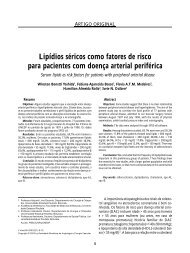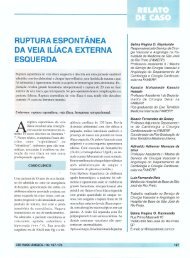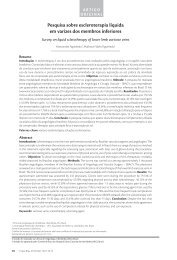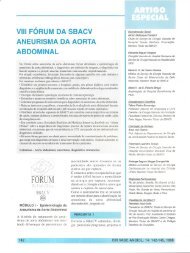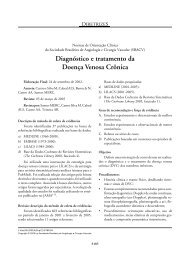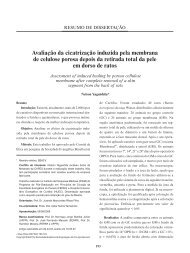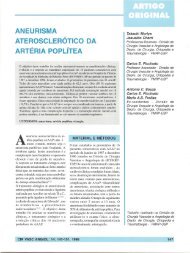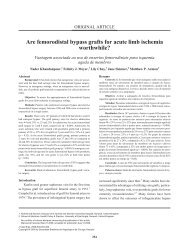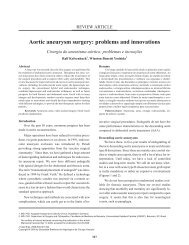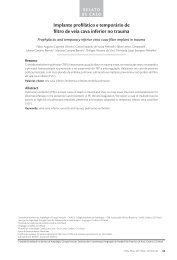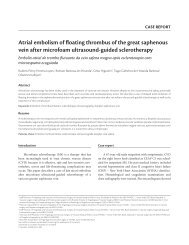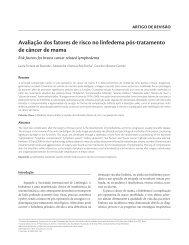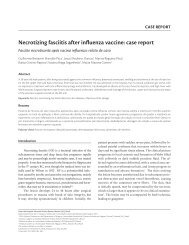Dissecção Espontânea da Carótida Interna
Dissecção Espontânea da Carótida Interna
Dissecção Espontânea da Carótida Interna
- No tags were found...
You also want an ePaper? Increase the reach of your titles
YUMPU automatically turns print PDFs into web optimized ePapers that Google loves.
Dissecgoo espontanea <strong>da</strong> caroti<strong>da</strong> interna: relata de caso e revisoo <strong>da</strong> literatura Ricardo J. Gaspar e cols.um era sabi<strong>da</strong>mente hipertenso, 11eram fumantes, urn apresentavadislipidemia e nenhum deles eradiabetico.. A DEECl ocorre em pacientesjovens com i<strong>da</strong>de media de 40 anossem desproporyao significativa comrelayao ao sex06.7,8,12,31,32.36.0 quadroclinico pode se apresentar comoparalisia de nervos craniais, Sindromede Horner, cefaleia, dor facial esintomas cerebrais, tais como deficitmotor e sensitivo, ou <strong>da</strong> retina comoamaurose monocular transit6ria oupermanente 22 , 24, 30. Os <strong>da</strong>dos <strong>da</strong>literatura sugerem que 1/3 a 1/2 dospacientes sofrem AVC que pode serprecedido por AIT em 1/50 dospacientes22, 24.o diagn6stico <strong>da</strong> DEECl pode serevocado quando 0 AVC estaassociado a cefaleia e Sindrome deHorner ipsilaterais, mas estaassociayao nao e comum 5 • Em casosmenos tipicos, que sao a maioria, 0diagn6stico somente e feito medianteestudo angiografico. 0 duplex scanpode mostrar estenose ou oclusiio,mas estes achados nao saoespecificos e a angiografia, mesmoassim, e necessaria. Por outro lado, 0duplex, por ser nao invasivg,constitui-se na tecnica ideal paraacompanhament05,16.39. No casopresente realizamos estudo comressonancia nuclear magnetica (RNM)com cortes transversais quemostravam imagens de septayiioevidenciando luz e trombo.Bogousslavsky e col.6 avaliaram1.200 pacientes consecutivos quetiveram urn primeiro AVC, dos quais2,5% (30 pacientes) foram causadosporDEECI.Em estudo desses 30 pacientes,com acompanhamento por seis anos,dos 2)3 que sobreviveram afase agu<strong>da</strong>,realizaram segmento com duplex quemostrou 57% de recanalizayiio. Amaioria ocorreu dentro do primeiromes, mas alguns, nos primeiros dias.Em nosso pacientes, 0 duplex realizadono 12°. dia ap6s AVC naomostrou estenose <strong>da</strong> Cl, possivelmentepor recanalizayao ou pelofato de 0 transdutor niio terconseguido acui<strong>da</strong>de mais distalmente.Melhora ou normalizayao doaspecto angiografico tern sido publicad04,I ~.14, 19, 20, 22, 23, 25, 26, 28, 29, 30, 31, 36,38, 40, 41 mas niio ha <strong>da</strong>dos quanta aotempo de recanalizayao. Recorrenciade dissecyao e extremamente rara.Ain<strong>da</strong> com relayiio ao aspectoangiografico, Bogousslavsky e col.5mostraram que dos 30 pacientesestu<strong>da</strong>dos, a Car6ti<strong>da</strong> lnternaEsquer<strong>da</strong> foi comprometi<strong>da</strong> em 13, aCar6ti<strong>da</strong> lnterna Direita em 16 e adissecyao foi bilateral em urnpaciente. A oclusao estava situa<strong>da</strong>entre dois e cinco centimetrosdistalmente abifurcayao <strong>da</strong> car6ti<strong>da</strong>.Dupla luz, assim como pseudoaneurisma,foi visto em urn paciente.Em todos os pacientes foram vistasirregulari<strong>da</strong>des parietais, masanormali<strong>da</strong>des sugerindo displasiafibromuscular foram observa<strong>da</strong>s emsomente quatro pacientes na car6ti<strong>da</strong>interna ipsilateral ou contralateral.Oclusiio de ramos intracerebraisipsilateral a dissecyiio sugerindoembolizayao distal foi vista em setedos dezenove pacientes nos quais seteve acesso angiografico.Segundo Sturzenegger 42 , emborarevisoes recentes ain<strong>da</strong> cosiderem aangiografia como padriio ouro, suacasuistica e outras sugerem que aRNM, metodo niio invasivo, e maissensivel e mais especifica.Com relayao ao tratamentocirurgico, em 14 tentativas dereparayao operat6ria com variayao detaticas houve oito falhas e apenasdois sucessos documentadosl 5 , 17. Osoutros 4 casos niio tiveramdocumentayiio.Ha alguma controversia a respeitodo progn6stico <strong>da</strong> DEECI. Variosautores tern mostrado uma naodesprezivel mortali<strong>da</strong>de deaproxima<strong>da</strong>mente 20% 2,8,9,10,11,18,32,35.43, mas outros tern enfatizado anatureza benigna <strong>da</strong> DEECl 15, 19,20,27,28,30,33,34,38,41,44. Esta discrepancia podeser explica<strong>da</strong> pelo fato de que as seriesmostrando boa evoluyao eramcompostas principalmente depacientes que nao apresentaramAVC,tendo sido 0 diagn6stico feito a partirde episodio de AIT ou paralisia denervos cranianos, enquanto quemortali<strong>da</strong>de precoce ou sequelaneurologica grave mostra<strong>da</strong>s emoutros pacientes foram devi<strong>da</strong>s ainfarto cerebral maciy0 6 . Os achadosde Bogousslavsky e coP mostraramque AVC devido a oclusiio <strong>da</strong> Cl pordissecyiio niio pode ser chamado deevento "benigno", ja que houve 23%de mortali<strong>da</strong>de na primeira semana e48% dos que sobreviveram foramincapazes de reassumir suasativi<strong>da</strong>des anteriores devido a gravelimitayao motora. Boa evoluyaofuncional foi associa<strong>da</strong> comrecanalizayao precoce <strong>da</strong> dissecyao ecom infarto cerebral pequeno,enquanto que rna evoluyiio foiassocia<strong>da</strong> com oclusao persistente <strong>da</strong>Cl, com grandes infartos e evidenciade embolia cerebral dista1 6 .Tern sido descrita recanalizayiiocom terapia anticoagulante3, 12, 19,20,26,29,30,42, mas tambem sem ela4, 23, 31, 36.Embara 0 usa precoce de heparinapossa parecer logica, seus beneficiospermancem sem comprovayiio, ate queurn estudo randomizado seja realizado.CIR VASC ANGIOL 13: 73-77, 1997
Dissec900 espontanea <strong>da</strong> caroti<strong>da</strong> interna: relata de caso e revisao <strong>da</strong> literaturaRicardo J. Gaspar e cols.Spontaneous dissection of the internal carotid artery. Case report.Introduction: Although rarely published before 1970, spontaneousdissection of the internal carotid artery is nowa<strong>da</strong>ys considered a not incommonvascular disease. A recent review of the literature revealed 300 cases andestablished the clinical features and the prognosis of ischemic neurologicevents due to this disease.Case discription: A thirty-two years old healthy male was admitted withan ischemic stroke due to spontaneous dissection of the internal carotid arteryas shown by arteriography and magnetic resonance of the carotid artery.After some weeks the patient cursed with almost no residual symptoms.Discussion: The physiopathologic mechanism of spontaneous dissectionof the internal carotid artery is unknown. One third to half the patients developa stroke. Of a series of 1200 patients with a first stroke, 2,5% showed it tobe caused by spontaneous dissection of the internal carotid artery. Of these,57% patients showed subsequent normalization of the carotid artery. Of 14cases submitted to a surgical procedure, there where eight faillures and inonly two cases a success could be documented. There is also controversyabout the prognosis. Functional recovery is associated with early recanalizationof the dissection whereas maintenance of neurologic symptoms showed tobe related to thrombosis of the carotid artery, cerebral infarcts and distalcerebral embolazation.Keywords: carotid artery, dissection, cerebral ischemia.1. Andersen CA, Collins GJ JR, RichNM: Spontaneous dissection of theinternal carotid artery associatedwith fibromuscular dysplasia. AmSurg 46:263-266,1980.2. Anderson RM, Schecheter MM: Acase of spontaneous dissectinganeurysm of the internal caroti<strong>da</strong>rtery. J Neurol Neurosurg Psychiatry22: 195-201,1959.3. Ast G, Woimant F, Georges B, LaurianC, Haguenau M: Spontaneous dissectionof the internal carotidy arteryin 68 patients. Eur J. Med 2:466-472.4. Barbizet J, Degos JD, Lamontte J:Dissection spontanee de la carotideinterne. Ann Med Intern 129:7376,1978.5. Bogousslavsky J, Despland P, RegliF: Spontaneous carotid dissectionwith acute stroke. Arch Neuro144: 137-140,1987.6. Bogousslavsky J, Regli F J: CurchodJ: Angiopathie reversible de I'arterecarotide interne. Med Hyg 43:30643070,1985.7. Bogousslavsky J, Regli F, DesplandP: Aneurysmes dissequantsspontanes de l'artere carotideinterne: Evaluation prospective duprognostic et de la repermeabilisationarterielle <strong>da</strong>ns 14 cas.Rev. Neurol11 :625-636,1984.8. Bostrom K, Liliquist B: Primarydissecting aneurysm of theextracranial part ofthe internal caroti<strong>da</strong>nd vertebral arteries. Neurology17:179-186,1967.9. Bra<strong>da</strong>c GB, Kaernbach a, Bolk Weischeldel D: Spontaneusdissecting aneurysm of cervicalcerebral arteries: Report of six casesand review of the literature.Neuroradiology 21: 149-154,1981.10. Brice JG, Crompton MR:Spontaneous dissection aneurysm ofthe cervical internal carotid artery. BrMed J 2:790-792,1964.11. Brown OL, Armitage JL:Spontaneous dissecting aneurysmsof the cervical internal carotid artery:Two cases reports and a survey ofthe literature. AJR 118:648-653,1973.12. Chappleau CE, Robertson JT:Spontaneous cervical carotid arterydissection: Outpatient treatment withContinous heparin infusion using atotally implantable device. Neurosurgery8:83-87, 1981.13. Contamin F, Ollat H, Wesley C.:Obstruction incomplete de la carotideinterne d'evolution regressive chezune malade atteinte de dy:tPlasie• CIRVASCANGIOL 13: 73-77,1997-------------------------------
Dissecgoo espontanea <strong>da</strong> caroti<strong>da</strong> interna: relata de caso e revisoo <strong>da</strong> literatura Ricardo J, Gaspar e cols,fibromusculaire. Semein Hop Paris59: 1393-1398,1983.14. Cusick JF, Daniels D: Spontaneusreversal in internal carotid arteryocclusion: Case report. J Neurosurg54:811-813,1981.15. Duche B: Dissection spontanees desarteres cervico-cerebrales: Analysede 52 cas et revue de la litterature,thesis. Bordeaux, France, 1986.16. Early TF, Gregory RT, Wheeler JR,Snyder SO, Gayle RG, Parent FN,Sorell K: Spontaneous carotiddissection: duplex scarming indiagnosis and management. J VascSurg 14:391-397,1991.17. Ehrenfeld WK, Wylie EJ:Spontaneous dissection of theinternal carotid artery. Arch SurgIII :1294-1301,1976.18. Farrel MA, Gilbert JJ, Kaufmann JCE:Fatal intracranial arterial dissection:Clinical pathological correlation. J.Neurol Neurosurg Psychiatry 48: 111-121,1985.19 .Fischer CM, Ojemann RG, RobersonGH: Spontaneous dissection ofcervicocerebral arteries. Can J NeurolSci 5:9-19,1978.20. Friedman WA, Day AL, Quisling RG:Cervical carotid dissectinganeurysms. NeuroSurgery 7:207214,1980.21. Garcia-Merino JA, Gutierrez JA,Lopez-Lozano JJ:Double lumendissecting aneurysm of the internalcarotid artery in fibromusculardysplasia. Stroke 14:815-818,1983.22. Gauthier G, Rohr J, WildiE:L'hematome dissequant de 1'arterecarotide interne: Revue generale de205 cas publies dont dix perssonels.Schweiz Arch Neurol NeurochirPsychiatr 136:53-74,1985.23. Gee W, Kaupp HA, Mc Donald KM:Spontaneous dissection of internalcarotid arteries: Spontaneousresolution documented by serialocular pneumoplethysmography an<strong>da</strong>ngiography. Arch Surg 115:944949,1980.24. h~'rt RG, Easton JD: Dissection ofcervical and cerebral arteries. NeurolClin 1:155-182, 1983.25. Hommel M, Pollack P, Gaio JM:Paralysie du nerf grand Hypoglossepar deux aneurysmes dissequant del'artere carotide interne. Rev Neurol140:415-421,1984.26. Kapp JP, Simth RR: Spontaneusresolution of occlusive lesions of thecarotid artery. J Neurosurg 56:7379,1982.27. Luken MG III, Ascherl GF Jr, CorrellJW, Hilal SK: Spontaneousdissecting aneurysms of theextracranial internal carotid artery.Clin Neurosurg 26:353-375,1979.28. Mas JL, Goeau C, Bousser MG:Spontaneous dissecting aneurysm ofthe internal carotid and vertebralarteries: two cases reports. Stroke16:125-129,1985.29. McNeill DH, Dreisbach J, MardsenRJ: Spontaneous dissection of theinternal carotid artery: Itsconservative management withheparin sodium. Arch Neurol 37:5455,1980.30. Mokri B, Sundt TM Jr, Houser OW:Spontaneous dissection of thecervical internal carotid artery. AnnNeurol19:l26-138,1986.31 .Montfort J, Degos J, Elzenbaum J:Aspect artheriographique dedysplasie fibromusculaire revele parune dissection de la carotide.32. Nomose KJ, New PFJ: Nonatheromatousstenosis andocclusion of the internal caroti<strong>da</strong>rtery and its main branches. AJR118:550-566,1973.33. O'Connell BK, Towfighi J, BrennanRW: Dissecting aneurysms of hea<strong>da</strong>nd neck. Neurology 35:993997,1985.34. O'Dwyer JA, Moscow N, Trevor R:Spontaneous dissecting of thecarotid artery. Radiology 137:379385,1980.35. Ojemann RG, Fischer CM, Rich JC:Spontaneous dissecting aneurysm ofthe internal carotid artery. Stroke3:434-440,1972.36. Pozzati E, Gaist G, Poppi M:Resolution of occlusion inspontaneously dissected caroti<strong>da</strong>rteries: Report of two cases. JNeurosurg 56:857-880,1982.37. Ringel SP, Harrison SH, NorenbergMD: Fibromuscular dysplasia:Multiple spontaneous dissectinganeurysms of the major cervicalarteries. Ann Neurol 1:301304,1977.38. Rosat P, Deramond H, GrunewaldP: L'anerurysme dissequantnoutramatique de la carotideinterne cervicale: Conduite a tenir.Neurochirurgirie 27: 133-137,1981.39. Rothrock JF, Lim V, Press G, GosingB: Serial magnetic resonance andcarotid duplex examinations in themanagement of carotid dissection.Neurology 39:686-692,1989.40. Sellier N, Chiras J, Benhamou M:Dissections spontanees de lacarotide interne: Aspects cliniques,radiologiques et evolutifs: Apropos de 46 cas. J Neuroradiol10:243-259,1983.41. Shuster E, Mokri B, Sundt TM:Spontaneous dissection of theinternal carotid arteries: Cliroicalpresentation, angiographicfeatures, and outcome. Neurology35 (suppl),1985.42. Sturzenegger M: Spontaneousinternal carotid artery dissection:early diagnosis and management in44 patients. J Neurol 242(4):231238,1995.43. Thapedi 1M, Asshennhurst EM,Rozdilsky B: Spontaneousdissecting aneurysm of the internalcarotid artery in the neck. ArchNeuro123 :549-554,1970.44. West TET, Davies RJ, Kelly RE:Horner's syndrome and hea<strong>da</strong>chedue to carotid artery disease. BrMedJ 1:818-820,1976.45. Zuber M, Meary E, Meder JF, MasJL: Magnetic resonance imagingand dynamic CT scan in cervicalartery dissections. Stroke 25:576581,1993.C1RVASCANGIOL 13: 73-77, 1997



